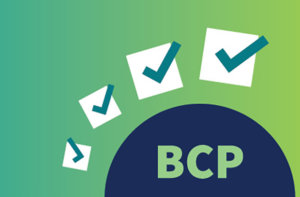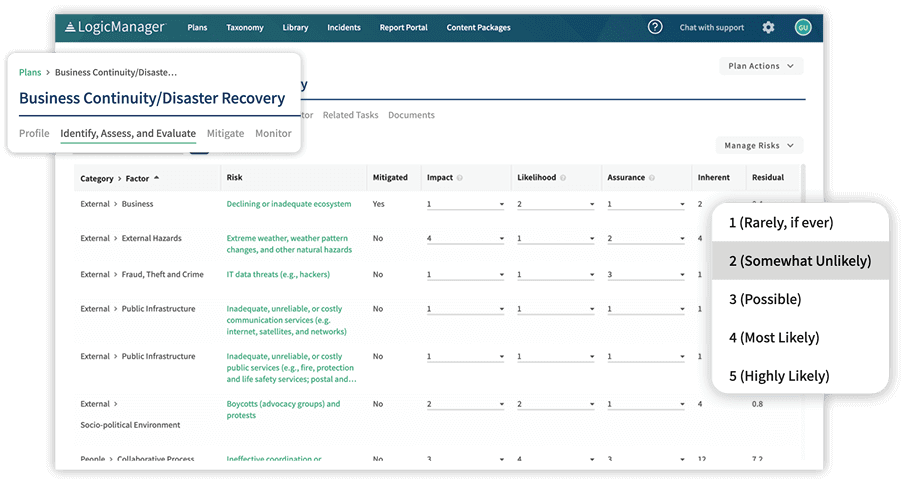What Does a Business Continuity Plan Typically Include? [Complete Guide]
Last Updated: September 19, 2023
Introduction
A business continuity plan (BCP) is your first line of defense against any challenge that threatens the core functionalities of your organization’s operations. When disaster strikes, your BCP should be there to reduce the time it takes to get things back up and running as usual again – as quickly as possible.
If you’re not able to react quickly to these types of incidents, your company could suffer physical harm, monetary losses, reputational damage, data integrity loss, litigation and much more.
Designing a BCP can feel overwhelming, as it’s such a critical document; where should you start? Who should be involved in the process? How should it be disseminated? These are all questions we’ll answer in this guide, including what is typically included in a BCP.
Bonus Material: Free BCP Checklist
How to Create a Business Continuity Plan
It’s important to actively invest time and energy into preparing for any potential risk before a potential event of a disaster so that if or when it does, your BCP directs you to the necessary resources to return to business as usual. That’s why creating and developing your BCP needs to involve a great deal of strategy and intention.
Taking a risk-based approach is the best way to go about developing your business continuity plan and avoid the need to use implement a disaster recovery plan. Through a risk-based approach, you follow the following steps: identify, assess, mitigate, monitor, connect and report. Here’s how to apply each of these steps during the lifecycle of your BCP:
- Start by identifying your most critical processes. When a business continuity event occurs, taking a risk-based approach ensures that you understand what the most critical processes to your organization are that need to be prioritized first to get back up and running to minimize any impacts.
- Next, assess your various risks. By evaluating all of the various types of risks that an incident could bring up – such as financial, reputational, customer, legal or strategic impact – you’re able to adequately determine which steps must be included in your BCP to minimize those impacts.
- Be sure to implement strategic mitigations as part of your business impact analysis. Building a business continuity plan through a risk-based lens empowers you to design more effective policies and procedures that simultaneously minimize the impact of the disruption at hand.
- Monitor the effectiveness of your controls over time. Otherwise, your BCP won’t align with your risks, leaving you likely to be caught off guard next time a business continuity event occurs.
- Your BCP does not exist in isolation, so be sure to connect departmental efforts. This allows you to identify interdependencies that must be known if an event occurs to ensure all steps are taken.
- Reporting is a key step in the risk-based approach, as it reveals patterns over time so that you can improve your BCP development where needed and keep your organization protected from any future disruption.
What Should my Business Continuity Plan Include?
Your BCP should include:
- An analysis of all critical functions within your business. This will allow for preparation of resources.
- A prioritized list of risks that pose a severe or even catastrophic threat to your business. These can be prioritized through risk tolerances and risk appetite so you can visualize which ones fall farthest out of that range.
- A list of specific strategies (or mitigation activities) that help protect the critical components you identified earlier in the BCP.
- Evidence that the strategies have been tested across critical business functions, using key metrics, indicators and financial scenarios.
- Dashboards and reports that uncover challenges and allow you to update the plan and your business processes over time.
Examples of Potential Unforeseen Risks
Naturally, your BCP will include risks that you deem a threat to your business. It can be difficult to begin writing that list when you’re not sure exactly what should be on it. In Risk Management, it’s important to consider potential risks that others may not have ever predicted to become reality (many people today say they never imagined in their lifetime that they would experience a pandemic).
Here is a list of potential unforeseen risks that pose a threat to business continuity:
- The sudden unavailability of a key vendor-provided service
- A regional power outage
- Abandonment in leadership
- Data protection issue
- Supply chain issues
- Privacy policy issues
- Getting sued
- An industry strike
- Pest infestation
- Natural disasters
- Winning the lottery
- Receiving a life-threatening diagnosis
- Getting in an accident
- A threat to national security, such as a terrorist attack
- Collapse of infrastructure
- And perhaps the most timely example of all, a pandemic (check out our complete guide to building a BCP for COVID-19 here)
BCP Best Practices
Like we mentioned earlier in this guide, it’s important to take a risk-based approach when creating your BCP. This will help you better preserve your business reputation, build up customer confidence and allow you to gain a competitive advantage. It will also ensure that you can avoid situations of disaster recovery. (Read our full guide on Business Continuity vs. Disaster Recovery)
To receive these benefits, it’s best practice to leverage robust business continuity planning software. This enables you to inherently take a risk-based approach and demonstrates to customers and stakeholders that you are prioritizing business continuity planning. This is especially true today amidst our ever-evolving disruptive business environment and the See-Through Economy.
Conclusion
Your business continuity plan will be different from anyone else’s, which is why it’s important to dedicate time and resources to creating one that fits your unique needs and risk factors. Working with a professional risk consultant is just one added benefit that’s included with your partnership with LogicManager. With their help, you’ll be able to better leverage the tools and resources included in our integrated ERM software, as well as our solution package for business continuity development.



